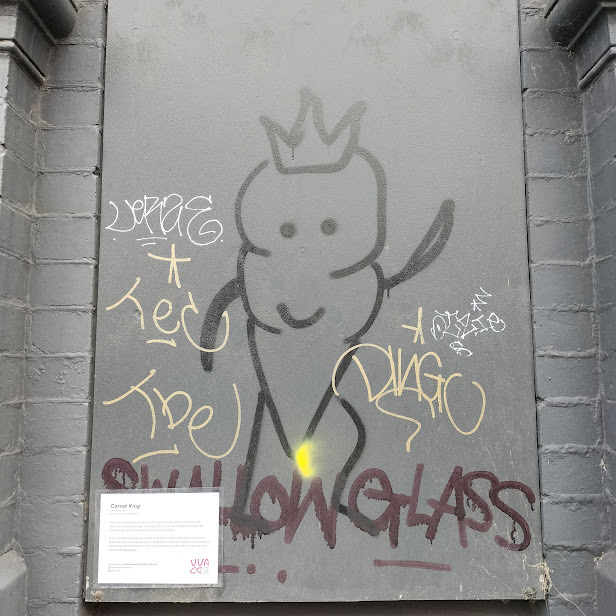A laminated card is attached to the wood panel. Like those of all of the didactic cards that explain the art in art museums, the method of attaching is discreet; one suspects some kind of adhesive. The wood panel to which it is attached has various tags in various colours from marker pens and mops dripping ink. There is a drawing of a carrot character with a crown. The panel is blocking a window on a brick building in a Brunswick laneway. Both the bricks and panel have been painted grey, which is currently a fashionable colour.
Imagine the world’s largest museum, where everything is in the collection and on exhibition. That place exists; it is called the world. Now, imagine that this museum has curators like the UUACC. The Upfield Urban Art Critics Collective provides mock curatorial panels with information and comments about pieces of street art scattered across Brunswick and Coburg. For example:
“Carrot King
Artist name, 2023
Spray-paint on weatherboard
“Within the confines of the dystopian realm posited by this piece, a content carrot becomes a surreal sovereign, challenging the very essence of governance and the transient nature of constitutional monarchy in Australia.”
“As the monochrome Apiaceae asserts its dominion with a jaunty wave, viewers are beckoned into a cerebral odyssey, to navigate the similarities and differences between Carrot King and King Charles III. The only conclusion the artist offers is they may very well be interchangeable.”
I checked the UUACC’s website again about Carrot King, and it states: “Sadly, this piece is no longer in our collection.”
The UUACC’s text is humorous and political, cheerfully aware of art speak and art theory. It is not an original action, but then again, nothing is these days. Melbourne street art’s mad scientist CDH “street art reviews” did it in 2013. In his notes on his project, CDH refers to another guerrilla curatorial group, New York’s ongoing The Street Museum of Art.
These guerrilla curatorial panels treat the street as a gallery. The point is to make a curatorial comment on street art and graffiti, not removed from the street in a blog (like this), but immediately and adjacent to the original Carrot King drawing. Curatorial support, with all the implied authority, for graffiti and street art stands against the authority of the lawscape of property. The authoritative language of the panels creates an ironic contrast to the anarchic direct actions of the city’s surfaces that the panel refers to. Guerrilla artists and curators suggest guerrilla cataloguers recording everything in a laneway, and guerrilla archivists storing it in a warehouse as large as the world.
The author is not now, nor has he ever been, a member of the Upfield Urban Art Critics Collective. Nor am I a fan of curatorial panels in art galleries; the minimum data is the artist’s name, title, date of creation, media, and provenance. This final item, provenance, is lacking in both UUACC’s text and, more significantly, that of most major Australian art galleries. Knowing the history of a work’s ownership helps prevent art theft and forgery (having previously been owned by Subhash Kapoor or Douglas Latchford now rings alarm bells). Ownership of street art and graffiti is a more complex question but one that the ethically responsible curators at the UUACC need to address.



June 3rd, 2024 at 5:52 PM
Love your work MH
June 3rd, 2024 at 6:23 PM
Cheers, Thank you.
June 4th, 2024 at 10:40 AM
Great review and very enlightening! Totally agree with your observations about Art Gallery didactic panels
Thank you, This has certainly lightened my day.
June 4th, 2024 at 11:10 AM
Cheers, Thank you. Art gallery didactic panels are such a weird contemporary things so they make a great subject for art jokes.
June 4th, 2024 at 2:02 PM
UUACC ‘Light at the end of the tunnel!’ I’m convert!
June 9th, 2024 at 4:18 PM
We thought provenance would be pretty bloody obvious, given, unlikes most galleries, in ours you’re standing right in front of the exact place it was made 🤷
June 9th, 2024 at 5:09 PM
Yes, provenance seems obvious, but I’ve been reading Sabina Andron’s Urban Surface, Graffiti and the Right to the City (2024), and she questions who owns urban surfaces, (particularly when there are several layers of graffiti aerosol paint underneath the current layer) rather than who controls the surface. And considering that auction houses have refused to sell Banksy walls that have been removed from the public. Also, provenance statements are essential to ethical curatorship.